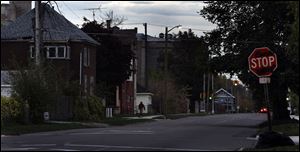
Solution to $4 million electric bill leaves Detroit enclave in dark
Highland Park removes 1,000 streetlights to cut costs
11/8/2011
The streets are mostly empty in Highland Park, where city officials worked out a deal with DTE Energy in late August to turn off and remove about two-thirds of the overhead lights.
HIGHLAND PARK, Mich. — As the sun dips below the rooftops each evening, parts of this Detroit enclave turn to pitch black, the only illumination coming from a few streetlights at the end of the block or from glowing yellow yard globes.
It wasn’t always this way. But when the debt-ridden community could no longer afford its monthly electric bill, elected officials not only turned off 1,000 streetlights, they had them ripped out — bulbs, poles, and all.
“How can you darken any city?” asked Victoria Dowdell, standing in the halo of a light in her front yard. She said the decision endangers everyone, especially people who have to walk around at night or catch the bus.
Highland Park’s decision is one of the nation’s most extreme austerity measures, even among the scores of communities that can no longer afford to provide basic services.
Other towns have postponed roadwork and closed libraries, for example. But to people left in the dark night after night, removing streetlights seems more drastic. And unlike many other cuts, this one appears to be permanent.
The city is $58 million in debt. With fewer than 12,000 residents, its population has dwindled to half the level of 20 years ago.
Faced with a $4 million electric bill that required $60,000 monthly payments, Mayor Hubert Yopp asked city council to consider reducing lighting. Council reluctantly approved it, even in an election year.
“We knew it was going to hurt,” Councilman Christopher Woodard said. “We’re all hurting.”
In late August, contractors from DTE Energy began rolling through the streets, taking out two-thirds of the light poles.
The city’s monthly electric bill has been cut by 80 percent. The amount owed DTE Energy goes back about a decade, but utility executives hesitated to turn off the juice.
“We are extremely concerned with public safety,” said Trevor Lauer, a spokesman for the Detroit-based utility. “We recognize that street lighting is something that contributes to public safety.”
In its heyday, Highland Park was one of Michigan’s urban jewels, with large yards, spacious homes, and tree-lined streets.
Henry Ford put his first moving assembly line here. By 1930, the city had grown to 50,000.
Ford Motor Co. moved its primary manufacturing operations to River Rouge, southwest of Detroit, in search of room to expand.
Highland Park survived that loss. But it never recovered from the then-Chrysler Corp.’s decision in the 1990s to move its world headquarters 25 miles north to Oakland County.
“That took away $6 million” in taxes, Mr. Woodard said. “That was a lot of money to not have anymore. When Chrysler moved out, things started to happen.”
Like Detroit, which lost 250,000 residents from 2000 to 2010, people moved out, leaving hundreds of abandoned houses.
The median household income is $18,700, compared with $48,700 statewide. And 42 percent of the city’s residents live in poverty.